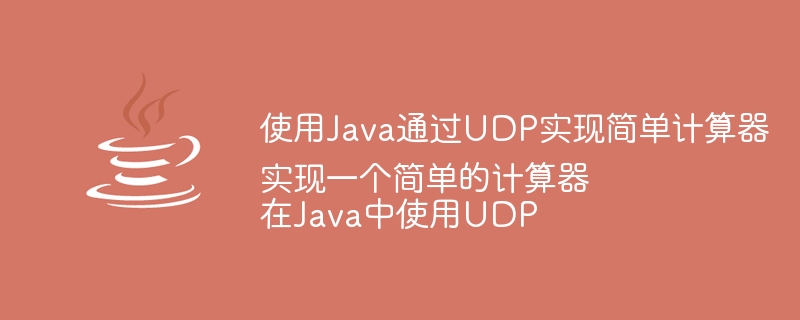使用Java透過UDP實作簡單計算器 在Java中使用UDP實作一個簡單的計算器
- 王林轉載
- 2023-08-27 21:33:021198瀏覽

網際網路協定套件包含所有類型的協議,使裝置之間能夠透過網際網路進行通訊。 UDP 是該套件的協定之一,其完整形式是用戶資料報協定。與 TCP 不同,它不可靠,而且是無連線協定。在發送資料之前,它不會與其他裝置建立任何類型的連線。
在本文中,我們將使用 Java 中的 UDP 開發一個簡單的客戶端伺服器端計算器。客戶端請求操作,伺服器計算後將結果傳送給客戶端設備。
Java 網路
讓我們先簡單了解一些關於Java網路的基本概念−
Inet位址
IP位址是一個32位元或128位元的無符號數字,用於唯一標識網路上的裝置。記住IP主機的名稱比記住數字位址更容易。因此,我們需要使用"InetAddress"類別來封裝它。我們使用它內建的方法"getLocalHost()"來取得本地主機的IP位址。
資料報
它們是小型資料包,包含可以透過網路在兩台機器之間傳遞的資料。 Java實作兩個類別來建立UDP連線 -
DatagramSocket類別用於傳送和接收資料封包。它還確定這些包的目的地。它內建的方法‘send()’和‘receive()’分別用於傳送和接收封包。
文法
DatagramSocket nameOfObject = new DatagramSocket();
DatagramPacket類別的物件儲存要傳送的資料。
文法
DatagramPacket nameOfPacket = new DatagramPacket();
使用UDP的計算機程式
客戶端程式
程式碼的工作原理
我們首先導入兩個最重要的包,名為'java.net',用於存取與Java網路相關的所有類,以及'java.io' ,用於輸入和輸出流。使用‘java.util’套件來使用‘Scanner’類別。
建立一個UDP連接,然後取得本機主機位址。
現在,在try區塊內部,我們將透過‘DatagramSocket’類別的‘send()’和‘receive()’方法來請求使用者輸入以請求操作並相應地接收結果。
import java.io.*;
import java.net.*;
import java.util.*;
public class ClientCalc {
public static void main(String args[]) throws IOException {
Scanner inp = new Scanner(System.in);
// making UDP connection
DatagramSocket datagsokt = new DatagramSocket();
// fetching the localhost address
InetAddress addr = InetAddress.getLocalHost();
byte strm[] = null;
try {
while (true) {
System.out.println("Type 1 for Addition");
System.out.println("Type 2 for Subtraction");
System.out.println("Type 3 for Multiplication");
System.out.println("Type 4 for Division");
System.out.println("Enter your choice: ");
String oprtr = inp.nextLine();
// to convert the user choice to byte
strm = new byte[256];
strm = oprtr.getBytes();
// creating datagram packet to send to server
DatagramPacket packtsend = new DatagramPacket(strm, strm.length, addr, 6666);
datagsokt.send(packtsend);
// Type 0 for cut the connection
if (oprtr.equals("0")) {
break;
}
// to receive the result from server
strm = new byte[256];
DatagramPacket packtrec = new DatagramPacket(strm, strm.length);
datagsokt.receive(packtrec);
// display the result
System.out.println("Your Result for the given operation = " + new String(strm, 0, strm.length));
}
}
// to handle exception
catch(Exception exp) {
System.out.println(exp);
}
}
}
伺服器端程式
程式碼的工作原理
-
首先,與客戶端建立連接,並定義 DatagramPacket 類別的兩個對象,以使用「DatagramSocket」類別的「send()」和「receive()」方法傳送和接收封包。
在try區塊內,我們接收來自客戶端的請求,然後使用switch case執行操作並將結果傳送到客戶端裝置。
範例
import java.io.*;
import java.net.*;
class ServerCalc {
public static void main(String[] args) throws IOException {
// making connection to client
DatagramSocket datagsokt = new DatagramSocket(6666);
byte[] strm = null;
DatagramPacket packtrec = null;
DatagramPacket packtsend = null;
try {
while (true) {
strm = new byte[256];
// to receive the packet from client
packtrec = new DatagramPacket(strm, strm.length);
datagsokt.receive(packtrec);
String oprtr = new String(strm, 0, strm.length);
System.out.println("Client has requested for " + oprtr );
int data1 = 15;
int data2 = 5;
int tot = 0;
char opt = oprtr.charAt(0);
switch(opt) {
case '1' :
tot = data1 + data2;
break;
case '2' :
tot = data1 - data2;
break;
case '3' :
tot = data1 * data2;
break;
case '4' :
tot = data1 / data2;
break;
default :
break;
}
// Converting the string result to integer
String res = Integer.toString(tot);
// converting the integer to bytes
strm = res.getBytes();
int port = packtrec.getPort();
// getting port number
// sending final result in the form of datagram packet
packtsend = new DatagramPacket(strm, strm.length, InetAddress.getLocalHost(), port);
datagsokt.send(packtsend);
}
}
// to handle exception
catch(Exception exp) {
System.out.println(exp);
}
}
}
要同時執行這兩個程序,在您的本機上同時開啟兩個cmd。在第一個cmd介面上,編譯並執行伺服器端程序,然後在另一個介面上執行客戶端程式。
客戶端輸出
D:\Java Programs>java ClientCalc Type 1 for Addition Type 2 for Subtraction Type 3 for Multiplication Type 4 for Division Enter your choice: 1 Your Result for the given operation = 20
伺服器端輸出
D:\Java Programs>java ServerCalc Client has requested for 1
當我們輸入0時,連線將被終止,程式將停止執行。
結論
在本文中,我們了解了 Java 網路的一些基本概念。此外,我們也討論了使用 UDP 的簡單計算器的伺服器端和用戶端程式。我們發現如何用 Java 在客戶端和伺服器設備之間建立連線。
以上是使用Java透過UDP實作簡單計算器 在Java中使用UDP實作一個簡單的計算器的詳細內容。更多資訊請關注PHP中文網其他相關文章!

